on Usability topics and techniques.
We invite you to subscribe
to our monthly e-newsletter.
Upcoming
workshops
| February 16, 2006 | Designing usable Web-based applications – Neo Insight Workshop |
| March 2 , 2006 | Usability challenges of new Web technologies – Neo Insight Workshop |
Upcoming
events
| February 23, 2006 | Interface design and ergonomics of an advanced immersive command workstation – CapCHI presentation by Tim Moore, Ergosum Ltd. |
| April 22-27, 2006 | CHI 2006, Montreal QC – Annual conference of the Special Interest Group on Computer-Human Interaction |
Much of usability research
and design is focused on making Web sites or Web applications easier
to use. However, too often we focus on the task-at-hand rather than
really trying to understand the higher-level goal that drives the user
to move from one task to another. In other words, we forget about the
“forest” as we concentrate on the individual “trees”.
Most human activity has a
flow to it, a series of tasks or activities which culminate in the person
achieving their goal. In web design, it is easy to ignore this overall
flow and context. Concentrating on improving the effectiveness and efficiency
of static Web pages, or even dynamic database query results, will only
take us so far. To move beyond this, we must develop a deeper understanding
of what the person is trying to accomplish. Let’s look at a few examples.
Recently, our company was
looking to buy a new colour printer. For this kind of purchase, many
shoppers have a goal to compare their options. However, several sites
had no support for comparison. We had to find each printer’s specifications
and pricing individually and then print them out or open multiple windows
to try and compare.
Other sites, like HP, create
a comparison table after the user checks off printers of interest. In
this example screen shot you can see the checkboxes on the left side.
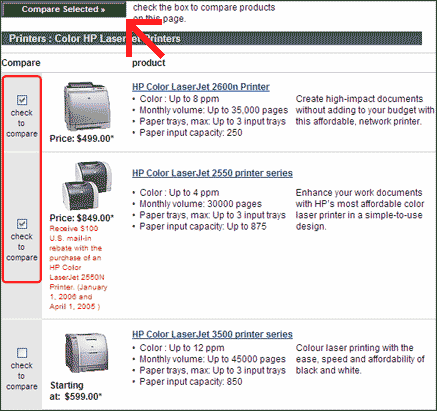
Link
to HP colour laser selection page
Clicking the “Compare
Selected” button near the top generated the following comparison
chart.
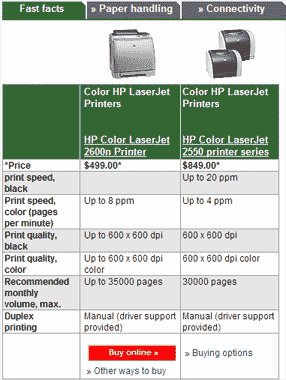
HP helped us
partially complete our goal because they allowed us to compare models
within our category of interest – color laser printers. However, it
wouldn’t help much if someone is unsure of what they want and has a
goal to find out what types of printers might best address their needs.
Dell caters
better to someone with the goal of getting recommendations. Their Printer
Advisor feature asks a few questions, as shown on the right in the following
screen shot. As you click various answers, the Printer Advisor dynamically
updates the range of options and the resulting matches are shown on
the left. This is a great way to obtain a manageable number of printers
to compare.
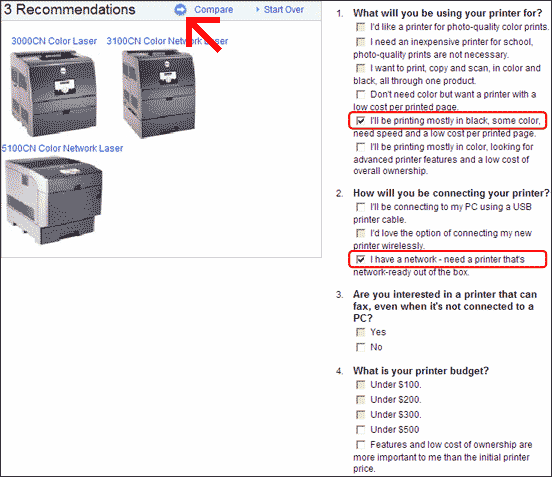
Link
to Dell’s Printer Advisor
When the “Compare”
link (centre top with arrow pointing to it) is clicked, a table is created
comparing your choices. Note that the Printer Advisor tries to differentiate
each printer and also bring the critical comparisons to the top of the
list; those that correspond to the criteria specified in the answers
given – for example, cost per printed page. This addresses not only
the task of comparing specifications and prices but also some of the
higher level goal of “comparing options against criteria important
to your business”.
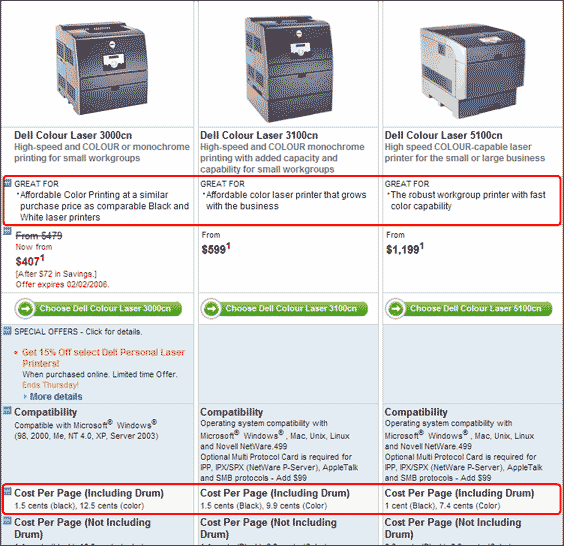
Unfortunately,
some other manufacturers have not quite grasped the concept designing
for the goals and tasks of comparison shopping. Lexmark’s Printer Guidester™
takes the user through a number of questions to narrow the choices but
ends up showing two models where the descriptions and specifications
are identical and yet one costs almost 3 times as much as the other.
Ignoring users’ goals and tasks is a recipe for some very frustrated
users.
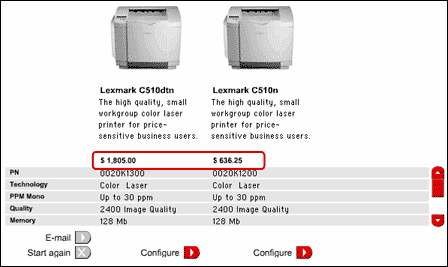
Link
to Lexmark’s Printer Guidester™
But, have Dell
and HP really addressed the ultimate goal of the user? Yes, they enable
people to see selected printers side-by-side, but they leave it to the
user to make the comparison on each attribute and determine which is
cheaper, faster, or whatever. All these sites support some elements
of the task of choosing a printer, but none of them fully support the
users’ goals.
In our new workshop,
“Designing usable Web-based applications”, we explore enhanced,
goal-oriented design practices in depth, demonstrating the application
of sound design and behavioural principles using many examples of good
and bad design (see the following news item).
Related resources:
- Donald Norman talks about Human-Centred
Design Considered Harmful


